Showing 771–780 of 1064 results

The book, proceedings of an international seminar, contains fourteen high-value research papers. It delves deep into the contributions of Sanskrit across varied fields of the knowledge system like linguistics, phonetics, philosophy, mathematics, grammar, medicine, ecology, management, Natya, public administration, poetry and poetics, among others.
This volume, a compilation of fourteen research papers of high value, presented at an international seminar organized by the Rajiv Gandhi Campus of Rashtriya Sanskrit Sansthan, Srngeri, highlights the contribution of Sanskrit to the development of world thought.
The first available text of the entire human race is Rigveda, and it is in Sanskrit. Since then the text-writing tradition of Sanskrit through ages has significantly contributed to the world thought, be it philosophy, mathematics, astronomy, grammar, medicine, ecology, public administration, poetry and poetics, among many other branches. Taking a cue from such a historical lineage, this volume showcases topics the contributions of ancient Indian thinkers to linguistics; some speculations on the contribution of Sanskrit to the world thought; significance of Ramayana in world literature; Sanskrits influence on Western phonetics; arthamatralaghava; elements of ecology in Ramayana; techniques of Theodor Stcherbatsky and his followers in translating Sanskrit philosophical texts; Sanskrits contribution to conscious studies; donation and value: its concept and expansion; Abhinavaguptas sarvamsarvatmakam; management wisdom which permeates in Sanskrit texts; twists and turns of Yoga in America; perspective of inspirational leadership from Gita; and reception of Natya in Europe, specifically in Croatia.
The icing on the cake is that the book presents research papers of the top three Sanskrit scholars of the world. This, with other scholarly articles, makes the volume a collectors choice.
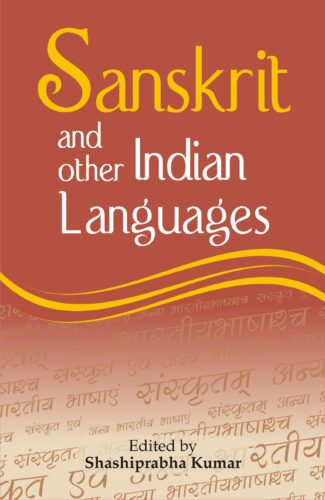
This book features the influence and interaction of Sanskrit with Prakrit, Hindi Apabhransha, Urdu, Bangla, Tamil, Telugu, Kannada, Malayalam, Assamese, Punjabi, Kashmiri and Gujarati. It modestly attempts to cover various aspects of mutual reciprocation between Sanskrit and other Indian languages.
This book is mainly a compilation of articles which were primarily presented at the Sanskrit Week Programme organized by the Special Centre for Sanskrit Studies, Jawaharlal Nehru University, New Delhi from 714 August 2006. A few articles have, however, been added later on. Sanskrit and Other Indian Languages features the influence and interaction of Sanskrit with Prakrit, Hindi Apabhramsha, Urdu, Bangla, Tamil, Telugu, Kannada, Malayalam, Assamese, Punjabi, Kashmiri and Gujarati. It covers various aspects of mutual reciprocation between Sanskrit and other Indian languages such as Þ conceptual, structural, grammatical, historical, linguistic, colloquial as well as literary. Issues of oral and written forms of language as also of textual translations have been dealt with by Sanskrit scholars who are well-versed in respective Indian languages. Finally, there is an article which argues for Sanskrit as a National Language of India. This book is a modest attempt to convey the inherent thought-pattern of Indian mind basically enshrined in Sanskrit but expressed through variety of verbal forms across the country.

The book is an attempt to present the Vithi and the Vithyangas in Sanskrit covering all aspects of theory and practice. Based on an in-depth study of source material the work examines several theories of rasa realization besides presenting a detailed treatment of hasya rasa.
Prahasana and the Vithi are two of the major playforms in Sanskrit Drama. Though studies on some individual prahasanas and vithis have appeared from time to time in research journals, there is no comprehensive study of the two playforms on comparative basis, undertaken so far. The present book is an attempt to cover all aspects of prahasana and vithi, in theory and practice. It is based on an in-depth study of manuscripts, microfilms and transcripts collected from various sources.
Beginning with the important aspects of Sanskrit drama, the book briefly examines the theories of rasa realization and presents a detailed account of the hasya rasa besides undertaking a study of the theoretical aspects of the prahasana first and the vithi in a later chapter, as sanctioned in the works on dramaturgy. It also presents an account of the suddha prahasanas that provide a contrasting picture in comparison with the samkirna variety. The work also analyses a few important vithi specimens. The chapter on the Vithyangas is a special feature of the work. Illustrations from well-known dramas serve to explain the textual matter with a rare clarity of thought and expressions.
This volume will interest scholars and students of Indology who are focused on the study of Sanskrit drama and dramaturgy, in particular, and literature, in general. It will also benefit readers interested in ancient Indian theatre.

Sanskrit education was a prime focus of the Pallava, Pandya, Cola, Vijayanagara, Nayaka and other kings of the Tamil country. Education was disseminated through agraharas, ghatikas, temple-colleges and mathas. Much authentic and interesting information about Sanskrit education and literature is available from the copper-plate grants and stone epigraphs.
Education, especially Vedic and Vedantic, along with allied subjects, was a prime focus of the rulers of the Tamil kingdoms. This book highlights the educational initiatives during the reigns of the Pallava, Pandya, Cola, Vijayanagara, Nayaka and other kings.
The inscriptions across the Tamil country talk about Sanskrit education in detail. Agraharas, ghatikas, temple-colleges and mathas were the main educational institutions propagating Sanskrit texts. The teachers were handsomely paid and bhatta-vritti was the norm of the day; villages were donated to them Þ either as ekabhoga or as agrahara (brahmadeya). There were poets and composers among the rulers, as an embodiment of their dedication to education. The numerous grants act as authentic sources of information on the reigns of these rulers, scholars, composers and educational institutions across many centuries Þ beginning from the Pallava times.
Giving a deep insight, this book is an invaluable source of information for students and researchers in the ancient and medieval history of India.
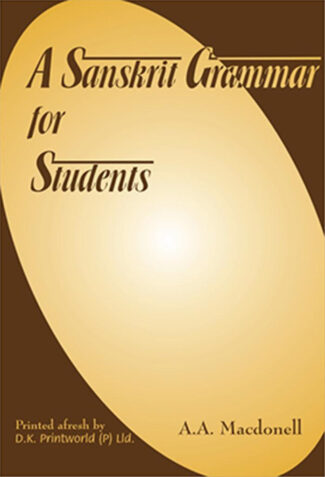
This fresh typesetting of Prof. Macdonells work explains the mechanics of the Sanskrit languages euphonic combinations (sandhi), declension, conjugation, nominal stem formation and compounds, etc., with insights into the syntactical arrangement of Sanskrit sentence.
It is an altogether fresh reprint of the eminent Orientalist, Arthur Macdonells A Sanskrit Grammar (1927 edition: Oxford). Which, ever since its first appearance, has been widely acclaimed both in India and elsewhere in the world, as an authentic, at once relevant account of classical Sanskrit.
Projecting, with well-chosen examples, a whole mass of grammatical forms to be met with in the post-Vedic Sanskrit literature, the author systematically explains the mechanics of its euphonic combinations (sandhi), declension, conjugation, nominal stem formation and compounds, and a lot else — with complete insights into the syntactical arrangement of Sanskrit sentence. Supported by several information-packaged appendices, the book also carries a brilliant resume of the Sanskrit grammatical tradition going back to the 5th century BC.
Now typeset anew with the latest technological aids, the late Macdonells work today remains as much indispensable to the students of Sanskrit as to the scholars, who seek to discover for themselves the splendour of its literary classics.
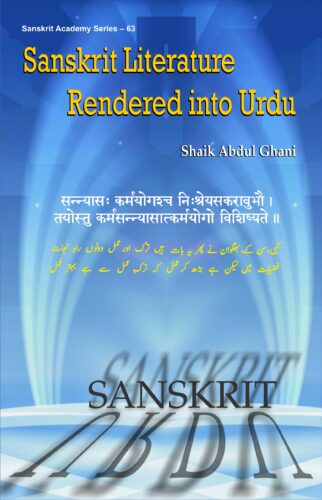
In the past many Sanskrit works were translated into Persian and other Indian languages so as to reveal the glory of the Sanskrit language and its literary output. This book presents details of the Urdu translations covering the Vedic literature the Puranas and classical works on various subjects.
Sanskrit literature is a vast tradition, its literary activity being one of the oldest in the world. In the past, many Sanskrit works were translated into Persian and other Indian languages so as to reveal the glory of the Sanskrit language and literary output to all. This book is an attempt to present Urdu translations of Sanskrit literature. The translations include the Gayatri mantra and a few random lines/verses from the Arthashastra, the epic literature especially the Bhagavad Gita, Kalidasas plays, Bahrtrharis Shatakas, the Yoga Darshana of Patanjali and the Kapila Sutras on Sankhya philosophy, in a simple manner and with clarity. It includes a detailed list of various works of Sanskrit translations into Urdu covering the Vedic literature, the Puranas, Sanskrit classical literature like the epics, drama, lyrics, poetry, prose, romance, popular tales and scientific literature on grammar, phonetics, medicine, the law, astronomy and mathematics.
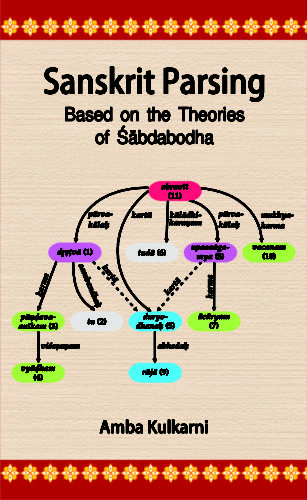
This book presents the key concepts from the Indian Grammatical Tradition (IGT) that are necessary for understanding the information flow in a language string and its dynamics. This is followed by a concrete application of building a parser for Sanskrit using the framework of Indian Grammatical Tradition.
India has a rich grammatical tradition, still extant in the form of Panini’s grammar as well as the theories of verbal cognition. These two together provide a formal theory of language communication. The formal nature of the theory makes it directly relevant to the new technology called Natural Language Processing.
This book, first presents the key concepts from the Indian Grammatical Tradition (IGT) that are necessary for understanding the information flow in a language string and its dynamics. A fresh look at these concepts from the perspective of Natural Language Processing is provided. This is then followed by a concrete application of building a parser for Sanskrit using the framework of Indian Grammatical Tradition.
This book not only documents the salient pieces of work carried out over the last quarter century under Computational Paninian Grammar, but provides the first comprehensive exposition of the ideas involved. It fills a gap for students of Computational Linguistics/Natural Language Processing who are working on Indian languages using Paninian Grammatical Framework for developing their computational models and do not have direct access to the texts in Sanskrit.
Similarly for the Sanskrit scholars and the students it provides an example of concrete application of the Indian theories to solve a contemporary problem.
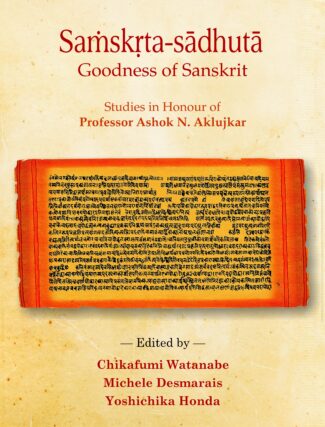
This book, felicitating Professor Ashok Aklujkar, throws light on the major areas of Sanskrit and related subjects, such as philosophy, religion, linguistics, poetics, art and sociology. It primarily contains essays exploring the complexities of Sanskrit grammars, Indic linguistic philosophy and the relation between Sanskrit and Pali.
Making any valuable and original contribution to the treasure troves of knowledge and world literature based on serious studies, deep thought, extensive research, intensive literary discourses and experience gained through continued exposure and involvement, is not everybody’s forte. It is for such literary acumen, intrinsic scholastic qualities and other personal attributes that make Dr. Ashok Aklujkar stand out and be regarded as the world-renowned Sanskrit scholar of the modern times in whose honour and appreciation this volume has been compiled and published.
Several leading and gifted scholars from across the world have contributed a wide range of interesting research articles for this special volume that deal with major areas of Sanskrit and related studies such as philosophy, religion, linguistics, poetics, art and sociology. As a befitting tribute to the scholarly interests and attainments, reflected in the published works of Prof. Aklujkar, essays exploring the complexities in Sanskrit grammars and Indic linguistic philosophy take the centre stage in this volume. Good care has also been taken to devote sufficient space to the poetics and the inherent relation between Sanskrit and Pali Þ the two other important areas Prof. Aklujkar has focussed on, from time to time.
In this compendium of assorted and absorbing articles authored by quite senior and well-known scholars of repute, appear alongside an equal number of articles from new generation, young scholars of merit, wherein they have attempted to offer the fruits of their original and critical research work.
The result: a panorama of interesting readings that introduce the reader to the unique diversity and richness of Indology from various vantage points.

This volume ranges over logic, grammar, philosophy, environment, aesthetics, interpretation, science, epic-poetry, India’s cultural presence in Asia, and maintenance of texts, and as such should interest students, researchers and teachers of languages, literature, sciences and philosophy.
The educated Indian mind of today is, by and large, subjugated by the contemporary ethnographic, conflict-oriented, divisive thought and ideologies of the West. This can be corrected only by the thought structure in the Sanskrit intellectual texts. Two learned Supreme Court judges noted in 1993 the people of India have always held in high esteem the cultural heritage of this ancient land. And learning of Sanskrit is undoubtedly necessary for protection of this heritage. And the 1986 education policy said, Efforts will be made to delve into India’s ancient fund of knowledge and to relate it to contemporary reality. This effort will imply the development of facilities for the intensive study of Sanskrit. With this in mind, JNU set up in 2002 the Special Centre for Sanskrit Studies to examine and relate Indian thought systems both to the contemporary Indian reality and the contemporary Western thinking. A research journal/publication is integral to this vision. This volume is the first issue and it promises a continuous commitment to Indian thought, its validity and value. We hope that this effort shall build a team of young scholars with a commitment to exact Indian scholarship. This book ranges over logic, grammar, philosophy, environment, aesthetics, interpretation, science, epic-poetry, India’s cultural presence in Asia, and maintenance of texts, and as such should interest students, researchers and teachers of languages, literature, sciences and philosophy. We would like the readers to enjoy this first volume. We welcome comments, observations, responses and also invite contributions for the next volume in the series.
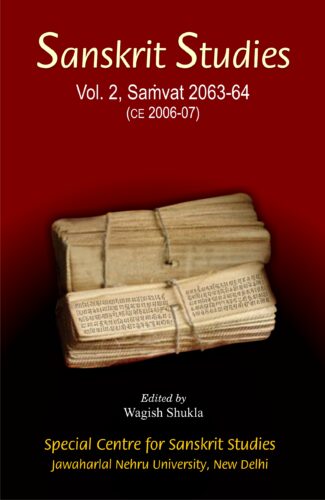
This is a second volume brought out by the Special Centre for Sanskrit Studies, JNU. It’s a collection of scholarly writings that throws light on ancient cultural heritage of India, marked by the Sanskrit intellectual traditions, dealing with schools of Vedas like Niruktas and the Itihasas, and the pre-Harappan Rgveda.
The cultural heritage of India is marked by the Sanskrit intellectual tradition whose flowering resulted in rich literature and development of philosophy, art and the sciences. Sanskrit Studies vol. 2 is the second issue showcasing the rich ancient heritage of Sanskrit brought out by the Centre. This volume is a collection of articles that throws light on various aspects of the Sanskrit tradition. The scholarly writings deal with schools of interpretation of the Vedas like the Niruktas and the Itihasas and evidences and arguments for a pre-Harappan date of composition for the Rigveda. They examine atomistic doctrines in Indian thought tradition, the charms and spells that constitute the Atharvaveda, the place of the Hindu women vis-a-vis ancient Indian society and traditions, and the philosophy and the aesthetics of rasa. Throughout they cite ancient Indian epics and mythologies, religious thoughts, literary works, philosophical traditions and scientific achievements to carry out a thorough and comprehensive study of the subject. There is an interesting article on issues involved in comparative studies of philosophies of two different traditions, as of the East and the West. The volume will appeal to students, teachers and scholars of Indology.
| There are no products |